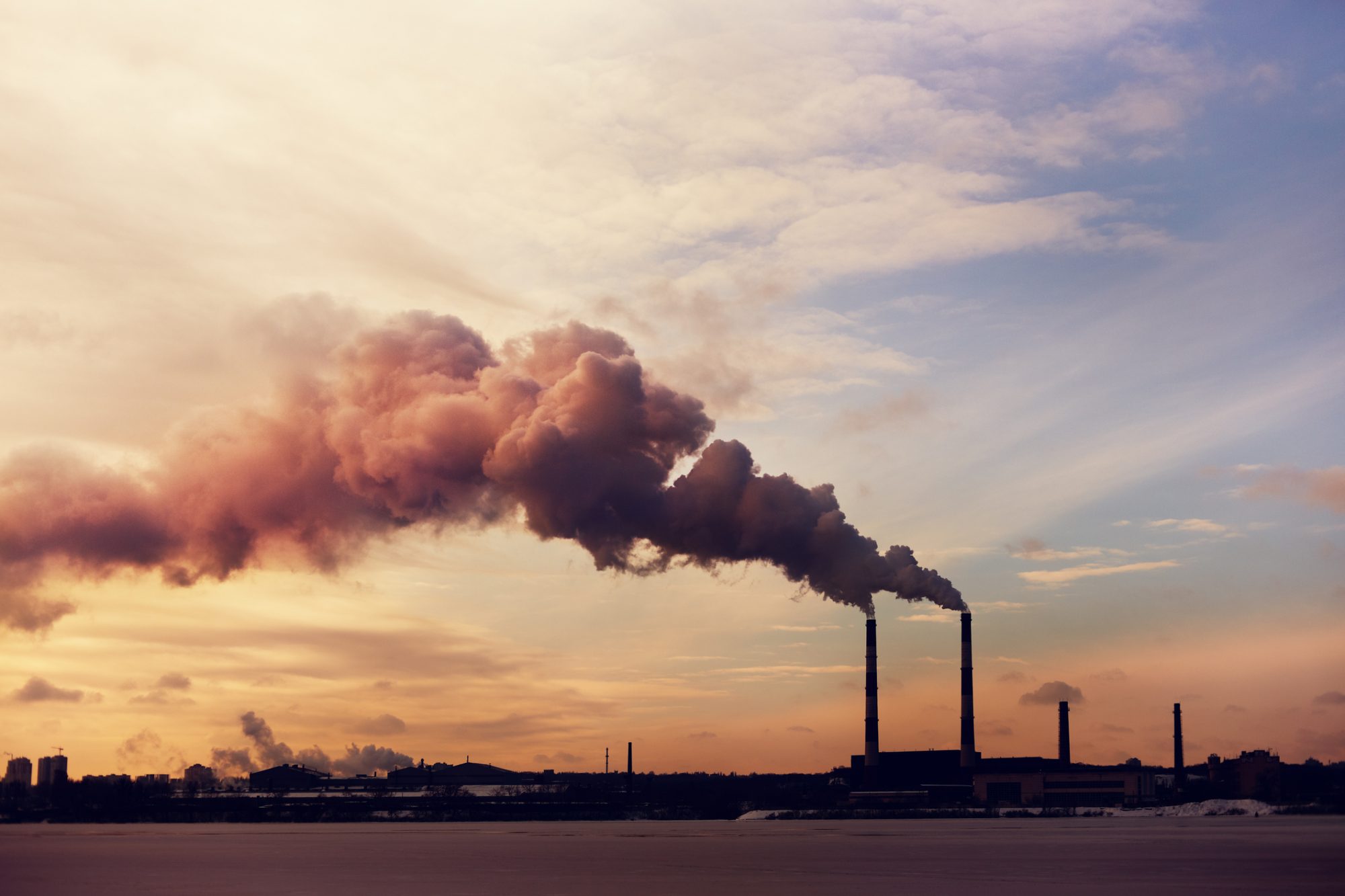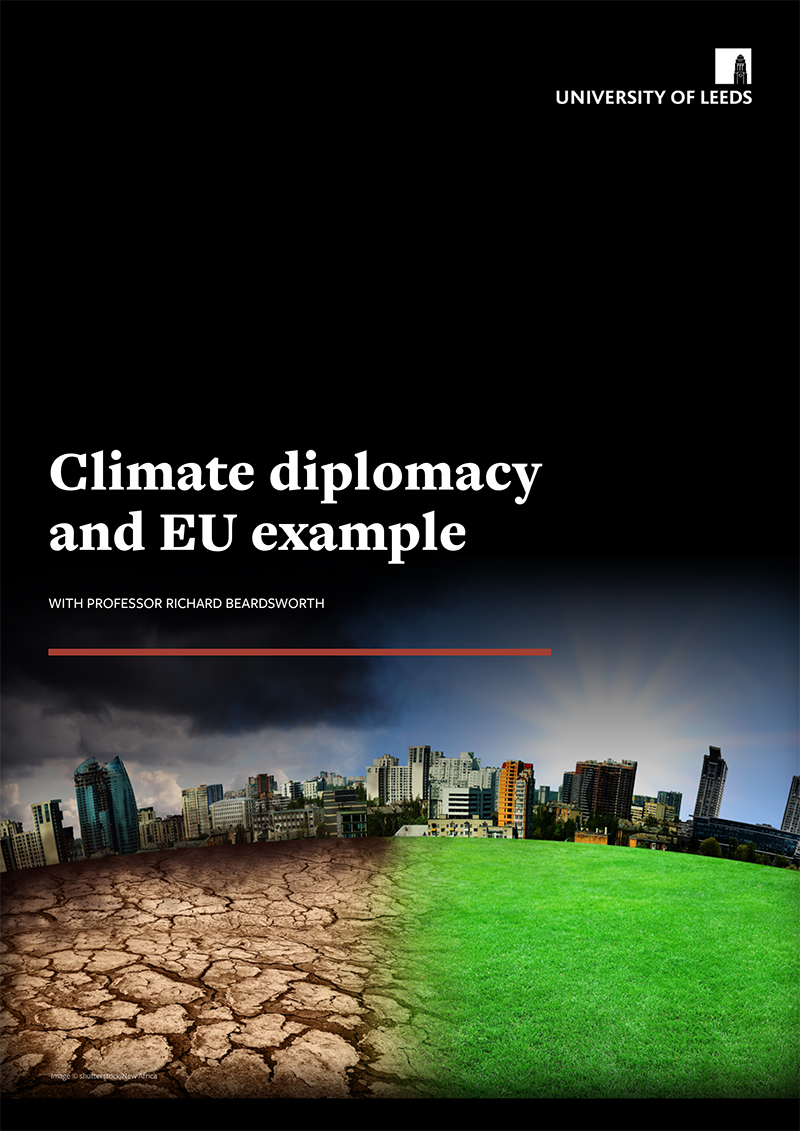Here we explore the importance of climate diplomacy with Richard Beardsworth, Professor and Head of School at the University of Leeds
The Climate Paris Agreement at the Conference of the Parties in 2015 (COP21) ratified two principles of climate action on behalf of the parties, the 196 signatory countries (including the EU region) to the agreement. The first confirmed the moral framework of the Kyoto Protocol. Due to their historical responsibility for climate change and their carbon-intensive development, it is equitable that developed countries ‘take the lead’ on climate ambition and action.
The second replaced the legal and political frameworks of the Kyoto Protocol. Climate ambition and action are channelled, not through a multilateral treaty with the leverage of international governance, but through the individual actions of states in an international environment of competition and collaboration – the mechanism of the Nationally Determined Contributions (NDCs).
In the absence of a multilateral climate treaty or effective international governance structure, climate diplomacy works from out of these two principles. It is diplomacy by example. A country or region sets an example by offering an ambitious NDC target and by continuously ‘ratchetting up’ this target at internationally agreed intervals.
At the same time, it sets an example by committing to international cooperation so that its domestic example not only convinces other countries to follow but accompanies outward-looking acts that promote the climate resilience and climate ambition of those parties unable to follow its lead without support. As a practice of exemplarity, climate diplomacy is simultaneously domestic and international.
2023 is an important year for climate diplomacy. The Paris Agreement set the average global temperature increase well below 2°C above pre-industrial times while pursuing means to limit the increase to 1.5°C. Its ‘global stocktake’ constitutes a periodic review of how far countries’ NDCs are in alignment with the target of 1.5°C, and the concomitant remaining global carbon budget (to date 250 GtCO2).
The first global stocktake concludes at COP28 in Dubai this December, negotiating agreement on the next round of targets. Its advanced report, published in September, notes that ‘system transformations are needed across all sectors and contexts’ if net zero (carbon neutrality) is to be achieved by 2050 (the UNFCCC condition of holding to 1.5°C by 2100). The overall challenge for climate diplomacy could not, therefore, be clearer: to set an example in transformative change.
This is also, however, a year of further geopolitical tension and polycrisis. The Russian invasion of Ukraine precipitated a global energy crisis which triggered in turn, on the back of two years of COVID and escalating debt in the Global South, a cost-of-living crisis as well as multiple food and water insecurities (at worst, famine in Africa and Asia). Further, all this is in the context of increasing tensions between democratic and authoritarian states, framed by the geopolitical rivalry between China and the US. Global energy systems account for 75% of GHG emissions.
Measures to mitigate these emissions account in turn for 75% of all mitigation measures to reach net zero. The energy transition from fossil fuels to clean energy lies therefore at the crux of climate diplomacy at the very moment when, following the post-COVID economic recovery and the energy crisis, GHG emissions continue to rise (the International Energy Agency (the IEA) reports that the world is 22 Gt CO2e above a 1.5°C scenario this year).
If one puts together these issues of contemporary domestic and international politics, the specific challenges for climate diplomacy and for the primary actors that wield it (governments and international institutions, national and international civil servants) are threefold:
- In the context of the climate and energy crises, to strike a balance between short-term energy security and the more medium and long-term priorities of climate mitigation and adaptation;
- Bringing the two crises together, to simultaneously manage the phase-down of all fossil fuels (and their eventual phase-out) and the scaling-up of renewables;
- To forge international political and financial support for clean energy in developing countries so that the ‘leap-frogging’ of carbon-intensive development remains a domestic political priority for the developing country.
These challenges are functionally interrelated. The balance between energy security and 1.5°C-aligned climate policy is predicated on managing successfully the energy transition. The latter is in turn predicated on scheduling appropriately the phase-in of renewable energy and the phase-down and phase-out of fossil fuels. Further, managing one’s own country’s energy transition means managing at the same time the transition of others given the variable geographical intensity of wind, solar and hydrogen energy (to choose the most important renewables).
These challenges are not interrelated politically however. The relations within and among each challenge are fraught with political tensions, tensions that make the climate diplomacy that aims to achieve the targets of the Paris Agreement—the diplomacy of example—a demanding practice.
The European Union has been considered a strong climate leader in recent years. It replaced the international leadership role of the US during the time of the Trump administration. It recurrently ratchets up its own regional net zero targets and constantly urges developing countries to move with its ‘sustainable and competitive’ example. Europe was the geographical region most vulnerable to the Russian invasion of Ukraine. In 2021 the EU imported an average 41% of its total gas consumption from Russia (with Germany and the east European member countries importing from 60 to 97%). Measure of success and failure in addressing the above three challenges of climate diplomacy can be effectively scrutinized by considering the example of the EU.

The EU’s Climate Diplomacy
The EU has positioned itself as a global leader in the fight against climate change for some time. Its example to others is most visible recently in the forging of a European Green Deal (EGD) (turned into climate law in 2021) and in its 2021 commitment both to reduce its GHG emissions by at least 55% by 2030 compared to 1990 levels and to scale up its renewables from 32% to 42.5% in its overall energy mix by 2030.
The EGD decouples economic growth from resource use, building a profile of proactive
policies towards sustainable and inclusive growth, and rethinking policies for clean energy supply across all major sectors of the economy (power, heating, transport, agriculture and land use, housing, industry and trade). Cognizant of the massive implications of the energy transition for both climate and the economy, the EGD breaks with the persistent neoliberal consensus in developed countries, offering instead classical industrial policy that stimulates markets towards climate-neutral production and consumption. Its example of industrial policy has been followed by the Biden administration in the Inflation Reduction Act of 2022.
The Russian invasion of Ukraine and its weaponisation of fossil fuel provision offered the EU the opportunity to ramp up its acceleration of renewable energy, but it also posed the immediate challenge of energy supply given its large dependence on Russian imports. Its REPowerEU plan (May 2022) sought rapidly to reduce dependency on Russia by, on the one hand, diversifying supplies and cutting energy costs and, on the other, accelerating further the clean energy transition.
In a rush of multilateral diplomatic moves during 2022, the EU, together with the more vulnerable and larger of its member states (foremostly Germany and Italy), sought out liquified natural gas (LNG) in the US, Qatar and Azerbaijan and fast-tracked existing fossil gas projects with Egypt and Israel and with countries in Sub-Saharan Africa, particularly Nigeria and Namibia.
The EU also opened up new gas projects with an array of countries in both North Africa and Sub-Saharan Africa (among which Algeria, Morocco, Ethiopia, Senegal, Mozambique, Mauritania and Angola). Many of these projects (offshore or with new entrants to the fossil fuel industry) will take up to 10 years to be developed. From both the perspective of the Paris Agreement and future energy security, they are of course deeply controversial.
REpowerEU legitimised its move to new developments by renaming fossil gas a climate- friendly ‘transition technology’—gas is cleaner than coal, etc.—and by scaling up the EU’s renewables target from 40 to 45% of its overall energy mix by 2030. Its parallel plan, EU External Energy Engagement in a Changing World (May 2022), justifies in turn its projected diversification of supply from African countries by lauding international energy partnerships that will give those countries the finance to pay for their own energy transition and by projecting an incremental switch in fuels from fossil gas to blue and green hydrogen (using carbon capture for the first and gas infrastructure for the transport and storage of the second).
As a result, the External Energy Engagement strategy aims to forestall the fate of carbon lock-in and stranded assets in African countries once the transition to renewable energy has taken place in Europe and the EU demand for gas imports dries up.
I have argued that climate diplomacy requires striking a convincing and effective balance
between short-term security concerns and longer-term climate concerns, managing together the phasing-down of fossil fuels and the scaling up of renewables, and forging international cooperation for clean energy development in more vulnerable countries. It could be argued that the EU’s overall plans for the diversification of energy supplies hold to the letter of climate diplomacy: the above policy declarations offer domestic and international examples of climate action and cooperation around a transition to renewables. However, as Stefano Mallia intimates in his editorial on EU inconsistencies in this e-book, its energy policies break with the EGD principle that climate action should inform all policy-making.
As the advanced report of the UNFCCC Global Stocktake and the IEA’s updated Net Zero Roadmap: A Global Pathway to Keep the 1.5°C in Reach have explicitly rehearsed this September, given the projected exponential increase in renewables, no new development of oil and gas is needed for the world to achieve both energy security and the Paris target of 1.5°C. With this in mind, the EU’s external gas strategy appears self-interested and hypocritical (dressing up its self-interest in the clothes of international collaboration on the energy transition). The former executive vice-president of the European Commission for the EGD, Frans Timmerman, has argued strongly for an interdependence between Europe and Africa that is founded on the future of two ‘civilisations of renewables’ (in particular, the provision of solar, wind, and hydrogen). It is clear from this vision that, in the context of the energy crisis, EU leaders are looking for a ‘win-win’ scenario.
In this scenario of Eurafrican energy interdependence, the EU gains immediate energy security for itself and secures sustainable development for African countries. Inversely, African countries meet their immediate development needs through fossil gas and secure finance for sustainable development. Let us consider the African response to the energy actions of the EU in 2022 to see if this climate diplomacy adds up.

Africa’s Needs
The countries that make up the African continent contain 1/5th of the world’s population (1.43 billion people), they emit 3% of global GHG emissions while being the continent most vulnerable to climate change, harbour up to 40% of the world’s renewables capacity but secure 3% alone of global energy investment. 600 million Africans (1/3rd of the population) do not have access to electricity and just short of one billion (2/3rds of the population) do not have clean fuel for cooking. Countries in Africa need access to secure, affordable and clean energy (SDG7), and their vast potential in renewables needs appropriate public and private investment (the first ever Africa Climate Summit in September 2023 speaks of $600 billion to 2030). At the COP27 meeting in Egypt in 2022 there were two strong positions advocated: one within the ‘Common Position’ of African governments (in particular energy ministers); the other by African and international civil societies (NGOs, non-fossil fuel interests).
The first argued for fossil gas as the means to meet their immediate priority: development (the reduction of poverty and secure and affordable access to energy). The second advocated rapid investment in renewables that delivers a decentralized energy system catered to the poor and short-circuits the threat of an unmanaged decline in exports. For many in the second grouping, the intentions of the first were not clear from the start given the economic, social and political consequences of the ‘resource curse’ in fossil fuel producing countries in Africa. For the first grouping climate ambition and action remain essentially the responsibility of the developed countries.
While the African Group of Negotiators (AGN) refused to adopt the explicitly pro-gas stance of the ‘Common Position’ at COP 27, at the 2023 Africa Climate Summit African leaders nevertheless stopped short of endorsing a ‘phase out’ of fossil fuels. By the time of the African Climate Summit, however, both fossil-fuel-producing countries and the African Development Bank (ADB) had produced a low-carbon transition narrative that explicitly used the EU’s post-energy-crisis denomination of fossil gas as a ‘transition technology’.
For the ADB, fossil gas remains a necessary condition of moving away from fossil fuels (the baseload argument), and the African Climate Summit Nairobi Declaration observes that appropriate financial support for Africa is necessary so that ‘no country [has] to choose between development aspirations and climate action’ (para. 37, my emphasis).
The EU’s promotion of a policy to further gas exploration and production in Africa, all the while pivoting itself as quickly as possible to renewables, has reinforced African countries willingness to use the same argument to legitimize its own continued use of gas in the name of sustainable development.
Following the Russian invasion of Ukraine, the African response to EU energy strategy has been threefold: i) civil resistance to a strategy that is considered hypocritical and a renewed danger for Africa as a whole (the extractivist trap); ii) government complicity with the international European-based majors (in Europe Shell, BP, Totalenergies) to fund longer-term gas projects in the name of security and development; and iii) exploitation of the terms of the EU’s recent energy policy to legitimise Africa’s further production of fossil fuels.
In this context, the EU leaders’ ‘win-win scenario’, rehearsed at the end of the last section, looks more like powerful interests on two continents using each other to justify the continued production of fossil gas. Whatever the exact truth behind EU decisions, the climate diplomacy of the EU breaks down here. A balance between energy security and climate goals has been struck for the EU, but it has not been struck for those African countries that will supply the EU with gas until EU demand for it has gone. The second and third challenges of climate diplomacy are accordingly not met either.
Conclusion
Investment in planned fossil fuel projects undermines the UNFCCC goal of 1.5°C and the carbon budget for it (250 GtCO2). Tracking the EU’s strategy of diversification of supply in Africa, together with African countries’ responses to it, shows how important it is today—as many climate activists have argued—for climate leaders to start with policies that are aligned with the remaining carbon budget. Following this alignment, the EU could provide a convincing domestic and international example by:
- Scheduling the phase-down (and eventual phase-out) of fossil fuels in tandem with the scaling up of renewable energy;
- Helping to provide both example and capacity for a similar phasing in African countries;
- Ramping up the public and private capital for clean energy investment so that both the energy policy and the schedule for energy transition are visible, trackable and accountable.
On the basis of these three climate actions (parts of which the EU is certainly already doing), the EU could then offer—at a historical moment when clarity and risk are desperately needed to effect transformative change—an unambivalent example of climate diplomacy to the world. Against the background of the direct weaponisation of climate by contemporary forms of populism, such bold risk-taking could not be more important.


